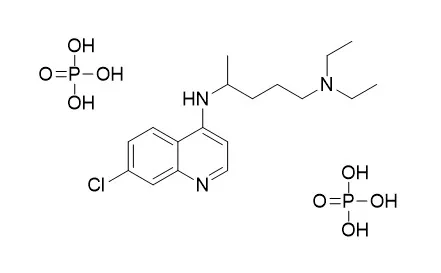| In vitro: |
| Pharmacol Ther,Feb-Mar 1993;57(2-3):203-35. | | Chloroquine: mechanism of drug action and resistance in Plasmodium falciparum.[Pubmed: 8361993] | Quinoline-containing drugs such as chloroquine and quinine have had a long and successful history in antimalarial chemotherapy. Although these drugs are known to accumulate by a weak base mechanism in the acidic food vacuoles of intraerythrocytic trophozoites and thereby prevent hemoglobin degradation from occurring in that organelle, the mechanism by which their selective toxicity for lysosomes of malaria trophozoites is achieved has been subject to much discussion and argument.
METHODS AND RESULTS:
In this review the recent discovery that chloroquine and related quinolines inhibit the novel heme polymerase enzyme that is also present in the trophozoite food vacuole is introduced. The proposal that this inhibition of heme polymerase can explain the specific toxicity of these drugs for the intraerythrocytic malaria parasite is then developed by showing that it is consistent with much of the disparate information currently available. The clinical usefulness of chloroquine, and in some recent cases of quinine as well, has been much reduced by the evolution and spread of chloroquine resistant malaria parasites. The mechanism of resistance involves a reduced accumulation of the drug, although again the mechanism involved is controversial.
CONCLUSIONS:
Possible explanations include an energy-dependent efflux of preaccumulated drug via an unidentified transmembrane protein pump, or an increase in vacuolar pH such that the proton gradient responsible for drug concentration is reduced. New data are also presented which show that heme polymerase isolated from chloroquine resistant trophozoites retains full sensitivity to drug inhibition, consistent with the observation that resistance involves a reduced accumulation of the drug at the (still vulnerable) target site.
The significance of this result is discussed in relation to developing new strategies to overcome the problem presented by chloroquine resistant malaria parasites. | | Lancet Infect Dis,2003 Nov;3(11):722-7. | | Effects of chloroquine on viral infections: an old drug against today's diseases?[Pubmed: 14592603] | Chloroquine is a 9-aminoquinoline known since 1934. Apart from its well-known antimalarial effects, the drug has interesting biochemical properties that might be applied against some viral infections.
METHODS AND RESULTS:
Chloroquine exerts direct antiviral effects, inhibiting pH-dependent steps of the replication of several viruses including members of the flaviviruses, retroviruses, and coronaviruses. Its best-studied effects are those against HIV replication, which are being tested in clinical trials. Moreover, chloroquine has immunomodulatory effects, suppressing the production/release of tumour necrosis factor alpha and interleukin 6, which mediate the inflammatory complications of several viral diseases. We review the available information on the effects of chloroquine on viral infections, raising the question of whether this old drug may experience a revival in the clinical management of viral diseases such as AIDS and severe acute respiratory syndrome, which afflict mankind in the era of globalisation. | | Curr Opin Microbiol,2000 Aug;3(4):349-53. | | Chloroquine and the fungal phagosome.[Pubmed: 10972492] |
METHODS AND RESULTS:
The antimalarial drug chloroquine accumulates inside the macrophage phagolysosome by ion trapping where it exerts potent antifungal activity against Histoplasma capsulatum and Cryptococcus neoformans by distinct mechanisms. Chloroquine inhibits growth of H. capsulatum by pH-dependent iron deprivation, whereas it is directly toxic to C. neoformans. Clearly, clinical studies are required to document the potential therapeutic efficacy of chloroquine or related congeners as adjuvant therapy in fungal disease. Moreover, the diversity of pathogenic microorganisms inhibited and/or killed by chloroquine makes this drug an attractive candidate for prophylactic therapy. |
|






 Cell. 2018 Jan 11;172(1-2):249-261.e12. doi: 10.1016/j.cell.2017.12.019.IF=36.216(2019)
Cell. 2018 Jan 11;172(1-2):249-261.e12. doi: 10.1016/j.cell.2017.12.019.IF=36.216(2019) Cell Metab. 2020 Mar 3;31(3):534-548.e5. doi: 10.1016/j.cmet.2020.01.002.IF=22.415(2019)
Cell Metab. 2020 Mar 3;31(3):534-548.e5. doi: 10.1016/j.cmet.2020.01.002.IF=22.415(2019) Mol Cell. 2017 Nov 16;68(4):673-685.e6. doi: 10.1016/j.molcel.2017.10.022.IF=14.548(2019)
Mol Cell. 2017 Nov 16;68(4):673-685.e6. doi: 10.1016/j.molcel.2017.10.022.IF=14.548(2019)